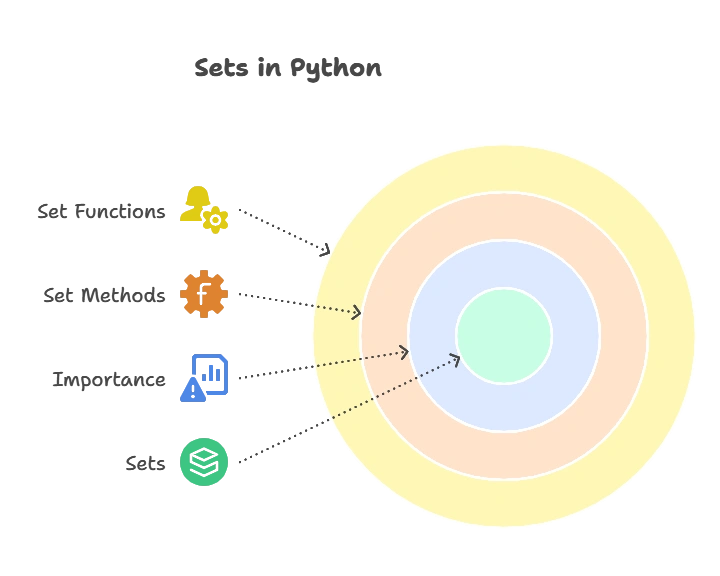Set Methods in Python
Set methods are unordered collections of unique elements, commonly used for mathematical operations such as union, intersection, and difference. In this topic, we'll explore various set methods that enable us to manipulate and work with sets efficiently. From basic operations like add() and remove() to more advanced techniques for set manipulation and intersection.
Understanding Sets in Python
In this section, we’ll cover the basics of sets in Python and understand their significance in programming.
What are Sets?
Sets in Python are unordered collections of unique elements enclosed within curly braces {}. Sets are mutable, meaning their elements can be changed after creation.
Why Sets are Important?
Sets are used to store unique elements and perform mathematical operations such as union, intersection, and difference. They provide a convenient way to work with collections of distinct items.
Set Methods vs. Set Functions
Set methods are functions that belong to the set object and are called using dot notation (set.method()), while set functions are standalone functions that operate on sets and are called with the set as an argument (function(set)).

Basic Set Methods
In this section, we’ll explore some of the most commonly used basic set methods in Python.
add() Method
The add() method adds a single element to the set.
my_set = {1, 2, 3}
my_set.add(4)
print(my_set) # Output: {1, 2, 3, 4}
Explanation:
- The
add(4)method adds the element4to the setmy_set.
remove() Method
The remove() method removes a specified element from the set.
my_set = {1, 2, 3}
my_set.remove(2)
print(my_set) # Output: {1, 3}
Explanation:
- The
remove(2)method removes the element2from the setmy_set.
Advanced Set Methods
In this section, we’ll explore advanced set methods that offer powerful functionalities for set manipulation and operations.
union() Method
The union() method returns a new set containing all the unique elements from both sets.
set1 = {1, 2, 3}
set2 = {3, 4, 5}
union_set = set1.union(set2)
print(union_set) # Output: {1, 2, 3, 4, 5}
Explanation:
- The
union()method combines the elements from bothset1andset2and returns a new set containing all the unique elements.
intersection() Method
The intersection() method returns a new set containing the common elements between two sets.
set1 = {1, 2, 3}
set2 = {3, 4, 5}
intersection_set = set1.intersection(set2)
print(intersection_set) # Output: {3}
Explanation:
- The
intersection()method finds the common elements betweenset1andset2and returns a new set containing those elements.
Set Operations and Testing Methods
In this section, we’ll explore additional set methods for performing set operations and testing elements in sets.
difference() Method
The difference() method returns a new set containing the elements that are present in the first set but not in the second set.
set1 = {1, 2, 3}
set2 = {3, 4, 5}
difference_set = set1.difference(set2)
print(difference_set) # Output: {1, 2}
Explanation:
- The
difference()method finds the elements that are present inset1but not inset2and returns a new set containing those elements.
issubset() and issuperset() Methods
The issubset() method returns True if all elements of a set are present in another set (i.e., the set is a subset). The issuperset() method returns True if a set contains all elements of another set (i.e., the set is a superset).
set1 = {1, 2, 3, 4, 5}
set2 = {1, 2, 3}
print(set2.issubset(set1)) # Output: True
print(set1.issuperset(set2)) # Output: True
Explanation:
- The
issubset(set1)method checks if all elements ofset2are present inset1. - The
issuperset(set2)method checks ifset1contains all elements ofset2.
We've delved into a comprehensive range of set methods in Python, covering basic operations, advanced manipulation, set operations, and testing functionalities. Sets are versatile data structures that offer efficient storage and manipulation of unique elements.
By mastering these set methods, you gain the ability to efficiently handle various tasks involving set manipulation, set operations, and element testing in Python. Whether you're adding or removing elements, performing union, intersection, or difference operations between sets, or testing for subset and superset relationships, Python's rich set of set methods provides powerful tools to accomplish your programming goals. Happy Coding!❤️
